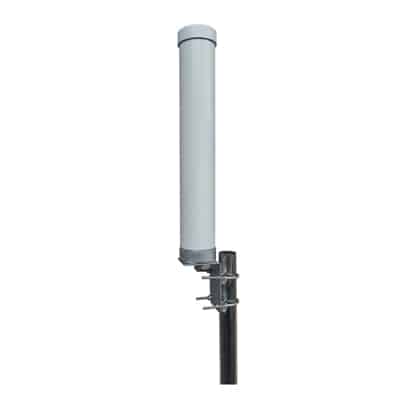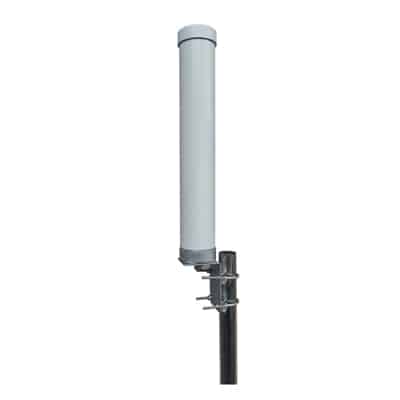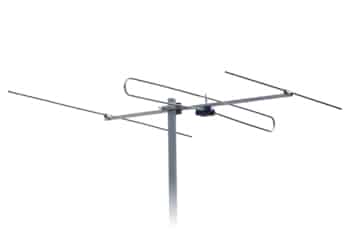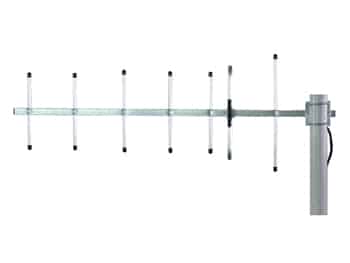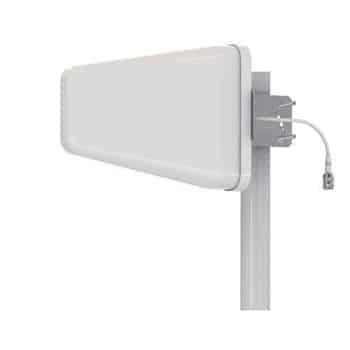
Mientras continúan los avances de la era 4G, la 5G ya está en el horizonte. Los avances en velocidad, eficiencia y capacidad que ofrecen los dispositivos móviles en poco tiempo son asombrosos. Este artículo ayuda a los lectores a entender las diferencias entre las antenas 4G y 5G y sus características.
Representará un salto significativo en conectividad, velocidad y capacidad, en la evolución de la tecnología de communicación inalámbrica de 4G a 5G. En realidad, el éxito de estos sistemas inalámbricos se debe a las antenas. Este artículo explica todas las diferencias en las bandas de frecuencia, los tipos, las ventajas y desventajas asociadas a las antenas 4G y 5G, y sus características en cuanto a latencia, capacidad, rendimiento y eficiencia energética. También examina los escenarios de aplicación y las tendencias futuras de las mismas, indicando cómo las antenas son la columna vertebral de las telecommunicaciones modernas.
Tabla comparativa: Antenas 4G frente a antenas 5G
| Característica | Antenas 4G | Antenas 5G |
|---|---|---|
| Bandas de frecuencia | 700 MHz - 2,6 GHz (por ejemplo, Banda 12/20/3/7) | Sub-6 GHz (600 MHz - 6 GHz) y mmWave (24 GHz y superiores, por ejemplo, 28/39 GHz) |
| Latencia | 30-50 ms | <1 ms (Ultrabajo para aplicaciones en tiempo real) |
| Velocidades de datos máximas | Hasta 100 Mbps (descarga), 50 Mbps (subida) | 10+ Gbps (Pico teórico) |
| Tecnologías clave | MIMO, formación de haces básica | MIMO masivo, Formación avanzada de haces, mmWave, Células pequeñas |
| Cobertura | Amplia cobertura; mejor penetración a través de obstáculos | Menor alcance (especialmente mmWave); dificultades con los obstáculos |
| Capacidad | Admite ~2.000 dispositivos por km² | Admite Más de 1 millón de dispositivos por km² (Escalabilidad masiva de IoT) |
| Eficiencia energética | Menor potencia por unidad, pero ineficiente para grandes cargas de datos | Mayor consumo de energía inicial, pero optimizado mediante modos de formación de haces/sueño. |
| Coste de implantación | Inferior (infraestructura madura) | Mayor (requiere redes densas de células pequeñas y hardware avanzado) |
| Aplicaciones típicas | Banda ancha móvil, streaming HD, IoT (wearables, contadores inteligentes) | VR/AR, vehículos autónomos, cirugía a distancia, ciudades inteligentes |
| Ventajas | - Amplia cobertura - Rentable - Fiable para zonas rurales | - Velocidades ultrarrápidas - Baja latencia - Conectividad masiva de dispositivos |
| Desventajas | - Velocidad/capacidad limitadas - Mayor latencia | - Alto coste de implantación - Alcance limitado (mmWave) - Poca penetración de obstáculos |
Índice
Toggle¿Qué es una antena 4G?
4G es la cuarta generación de tecnología de telecomunicaciones móviles. En comparación con las generaciones anteriores, esta tecnología de communicación móvil inalámbrica 4G se caracteriza por una mayor velocidad de transferencia de datos, un acceso a la red más estable y una mayor capacidad de llamadas de voz y vídeo. Las redes 4G permiten velocidades de carga de hasta 50 Mbps y de descarga de hasta 100 Mbps. Gracias a su baja latencia y a un almacenamiento en búfer insignificante, los usuarios pueden acceder con facilidad a aplicaciones con muchos datos, juegos en línea y transmisión de vídeo HD en dispositivos móviles.
Una antena 4G está especialmente diseñada para recibir y enviar señales en la red móvil 4G. La antena 4G se utiliza para mejorar la intensidad de la señal y la cobertura de una red 4G con el fin de aumentar la velocidad y la fiabilidad de la transferencia de datos. Estas antenas admiten tecnologías de múltiples entradas y múltiples salidas (MIMO) que ofrecen datos de alta velocidad y una mejor eficiencia del espectro. Las antenas 4G suelen ofrecer cobertura de área amplia, velocidades relativamente pequeñas y fiabilidad; suelen funcionar en rangos de frecuencia de 700 MHz hasta 2,6 GHz. Para mejorar la conectividad y el rendimiento de la red, las antenas 4G suelen desplegarse en aquellas zonas, rurales o remotas, donde las señales son bastante débiles o inestables.
¿Qué es una antena 5G?
5G es la quinta generación de tecnología de redes celulares inalámbricas. Básicamente, se puede mencionar como el sustituto de 4G LTE, que viene con una mayor capacidad, menos latencia y velocidades más rápidas comparativamente. La red 5G es necesaria para aplicaciones como la realidad virtual, la realidad mejorada, los coches autónomos y el Internet de las Cosas (IoT), que utilizan bandas de alta frecuencia y complejas tecnologías de antena para lograr velocidades de datos más rápidas.
Una antena 5G desempeña un papel importante a la hora de proporcionar conectividad de alta velocidad y baja latencia en dispositivos de arquitectura de red 5G para transmitir y recibir señales. Estas antenas admiten tecnologías avanzadas como la formación de haces, MIMO masivo y frecuencias de ondas milimétricas (onda mm) para permitir funciones de alto nivel. Principalmente operan en los rangos de frecuencia de sub-6 GHz a mmWave (24 GHz y superiores).
Esta antena para communicación inalámbrica 5G, que transmite y recibe señales tanto en la onda mm como en rangos de frecuencia sub-6GHz, ayuda a mantener sus prestaciones. Las antenas 5G dependen del rango de frecuencias y de los requisitos específicos de la red 5G.
Bandas de frecuencia
Gama de frecuencias de antena 4G
Las antenas 4G están diseñadas para funcionar entre las bandas de frecuencia 700 MHz y 2600 MHz, lo que permite su uso en todo el mundo. Sin embargo, las bandas específicas pueden variar según la región y el proveedor de red. El rendimiento general de la antena se ve afectado por su banda de frecuencia, que es esencial para establecer el área de cobertura y la penetración de la señal a través de obstáculos.
Las bandas de frecuencia más utilizadas para las redes 4G son: 700 MHz (Banda 12/13/17), 800 MHz (Banda 20), 900 MHz (Banda 8), 1800 MHz (Banda 3), 2100 MHz (Banda 1), 2600 MHz (Banda 7)
Estas bandas son utilizadas por muchas tecnologías 4G como WiMAX (Worldwide Interoperability for Microwave Access) y LTE (Long-Term Evolution). Precisamente qué bandas de frecuencia utilizará una antena 4G depende tanto del proveedor de red como de la zona en la que se utilice.
Gama de frecuencias de antena 5G
Dependiendo de la aplicación, el 5G utiliza una amplia gama de frecuencias, incluidas las bandas sub-6 GHz y las bandas mmWave (24 GHz y superiores).
- Sub-6 GHz: se trata de frecuencias como 600 MHz, 2,5 GHz y 3,5 GHz, todas ellas inferiores a 6 GHz. Este tipo de frecuencias son relativamente buenas para penetrar a través de paredes y otras barreras; pueden utilizarse para proporcionar cobertura de área amplia.
- Onda mm (onda milimétrica): Abarca las frecuencias superiores a 24 GHz, como 28 GHz y 39 GHz. Estas frecuencias tienen una cobertura limitada, se bloquean fácilmente por obstrucciones, pero se utilizan para communicaciones de alta velocidad en distancias cortas y ofrecen velocidades de transferencia de datos muy altas.
Las bandas de frecuencia baja, media y alta son otra forma de clasificar la 5G. Para un rendimiento óptimo, 5G puede utilizar más frecuencias en las tres bandas, y puede potencialmente utilizar múltiples frecuencias simultáneamente. Por ello, las bandas 5G son más adaptables que las anteriores generaciones celulares y ofrecen mejor cobertura y fiabilidad. Cada banda de frecuencia tiene características y capacidades distintas.
1. Banda baja:
En comparación con otras bandas, la banda baja 5G ofrece más cobertura pero un caudal de datos más lento porque utiliza frecuencias inferiores a 1 GHz. La transmisión de señales a larga distancia y la penetración de la señal a través de obstáculos como árboles y edificios son características de las antenas de banda baja. En general, son más grandes y tienen menos ganancia que las antenas de frecuencias más altas.
2. Banda media:
Las frecuencias utilizadas por la banda media 5G oscilan entre 1 GHz y 6 GHz. Con una cobertura menor que la banda baja, proporciona velocidades de datos más rápidas manteniendo el equilibrio entre capacidad y cobertura. Las antenas de banda media ofrecen una mayor ganancia y son más pequeñas que las de banda baja. Se utilizan con frecuencia en las ciudades para dar acceso a Internet rápido a muchos clientes.
3. Banda alta:
mmWave (onda milimétrica), o banda alta 5G, se refiere a 5G en frecuencias superiores a 24 GHz. Aunque tiene un área de servicio muy limitada y se bloquea fácilmente por edificios y otros obstáculos, ofrece velocidades muy altas. Las antenas de banda alta son de pequeño tamaño y tienen una ganancia muy alta para compensar la cobertura restringida. Suelen instalarse en ciudades muy pobladas y ofrecen una conectividad extremadamente rápida y de baja latencia.
La gama exacta de frecuencias puede cambiar, ya que los distintos países y regiones pueden utilizar bandas de frecuencia diferentes para la 5G.
Tipos de antena
Resumen de common Tipos de antena 4G
- Antena MIMO (entrada múltiple, salida múltiple)
Este tipo de antena 4G utiliza varias antenas de transmisión y recepción para aumentar la velocidad y fiabilidad de los datos. Para proporcionar velocidades de datos extremadamente altas, las redes móviles 4G utilizan la tecnología MIMO tanto en el canal de subida como en el de bajada. La base de la tecnología MIMO es el uso de varios sistemas de antenas tanto en la estación base como en el terminal móvil.
- Formación de haces:
Envía señales directamente a los usuarios para aumentar la capacidad y la cobertura. La tecnología Beamforming, una sofisticada técnica de procesamiento de señales, es utilizada por las antenas 4G para guiar la energía de la transmisión a un usuario o dispositivo concreto. Además de mejorar la calidad de la cobertura y la eficiencia de la señal, esto también reduce las interferencias y el derroche de energía.
Visión general de Tipos de antena 5G
- MIMO masivo:
La tecnología MIMO masiva (entrada múltiple, salida múltiple) se utiliza normalmente en las antenas 5G. Al emplear docenas o incluso cientos de elementos de antena de emisión y recepción, esta tecnología potencia la capacidad y eficiencia de la red, permitiendo dar servicio simultáneo a más clientes. En comparación con la tecnología MIMO de 4G, esto representa un gran aumento en la cantidad y complejidad de las antenas.
- Células pequeñas:
Las antenas 5G pueden hacerse más pequeñas y compactas, ya que las transmisiones de alta frecuencia tienen longitudes de onda más cortas. Esto permite desplegarlas con mayor libertad en diversos entornos, como instalaciones interiores, superficies de edificios y postes de la luz.
Ventajas de la antena 4G y la antena 5G
Antenas 4G
- Cobertura de área amplia:
En comparación con los routers Wi-Fi tradicionales, las antenas 4G pueden ofrecer un área de cobertura mayor. Esto garantiza que los usuarios experimenten una degradación mínima de la señal incluso a mayores distancias de la fuente de red. Esto es especialmente útil en lugares donde el servicio de banda ancha es limitado o en lugares remotos donde las conexiones a Internet por cable podrían no ser accesibles.
- Tecnología madura con infraestructura consolidada
La instalación y configuración de la antena 4G es mucho más sencilla en comparación con la antena 5G. Se pueden conectar fácilmente a un ordenador o a una red mediante un cable ethernet o un puerto USB, y suelen venir con instrucciones directas. Por lo tanto, son una buena opción práctica para los usuarios que no dominan la tecnología o que no prefieren ocuparse del engorro que supone configurar una conexión a Internet convencional.
- Despliegue rentable
Las antenas 4G pueden ser una opción asequible, para los usuarios sin acceso o los usuarios que no están dispuestos a pagar por una conexión estándar a Internet. Suelen ofrecer planes de datos ajustables que permiten a los clientes seleccionar la cantidad de datos que utilizan y facturar en consecuencia. Los usuarios con patrones de uso de Internet variables o los que sólo necesitan conexión a Internet durante un breve periodo de tiempo suelen encontrar esto especialmente útil.
- Fiabilidad
En comparación con las redes convencionales, los routers Wi-Fi, la antena 4G puede ofrecer una conexión a Internet más fiable y estable. Esto se debe a que utilizan transmisiones celulares, que suelen ser menos vulnerables a las interferencias y también más fiables que las conexiones Wi-Fi. Por lo tanto, es menos probable que los usuarios se encuentren con desconexiones inesperadas o caídas en la velocidad de Internet.
Antenas 5G
- Capacidad y velocidades ultrarrápidas
En comparación con las antenas 4G, las antenas 5G están diseñadas para soportar velocidades de datos mucho mayores. Gracias a ellas, los clientes podrán cargar y descargar datos a mayor velocidad, lo que les permitirá jugar en línea, ver vídeos en HD y descargar archivos de gran tamaño más rápidamente.
- Baja latencia en aplicaciones en tiempo real
La 5G tiene una latencia mucho menor que la 4G, gracias a las mejoras en la tecnología de antenas y la arquitectura de red. La latencia es la diferencia de tiempo entre el envío de una solicitud y la recepción de una respuesta. Con una latencia reducida, los usuarios pueden communicarse casi instantáneamente. Esta latencia es demandada por aplicaciones como la realidad virtual, la cirugía a distancia y los vehículos autónomos.
- Conectividad IoT con gran escalabilidad
Como las antenas 5G son más capaces de albergar más capacidad, pueden manejar más dispositivos a la vez. Esto es muy importante en zonas donde hay muchas personas conectadas a la red a la vez, como estadios, centros comerciales y aeropuertos.
- Uso de la tecnología Beamforming
Las antenas 5G cuentan con una avanzada tecnología de formación de haces que tiene la capacidad de concentrar la señal en una dirección específica. Esto ayuda a aumentar el rendimiento general al reducir las interferencias y mejorar la calidad de la señal.
Desventajas de la antena 4G y la antena 5G
Antenas 4G
- En comparación con 5G, velocidad y capacidad limitadas
La antena 5G tiene la posibilidad de manejar velocidades de datos de hasta 10 Gbps mientras que las antenas 4G se detienen en los 100 Mbps. Esta es la razón por la que las antenas 4G son un poco más lentas y no pueden manejar tanta información como las antenas 5G.
- Mayor latencia
La latencia de la antena 4G es mayor que la de la antena 5G. La latencia es el tiempo que tardan los datos en viajar desde su origen hasta su destino. Las antenas 5G tienen un retardo inferior a 1 milisegundo, mientras que las antenas 4G suelen tener una latencia superior a 50 milisegundos. Aplicaciones como la cirugía a distancia o los vehículos autónomos que requieren communicación en tiempo real son esenciales para tener una latencia menor.
- Capacidad limitada
Las antenas 4G tienen una capacidad limitada para soportar muchos dispositivos al mismo tiempo. Esto supone un problema durante eventos en los que todas las personas utilizan sus dispositivos o en lugares con alta densidad de población. Por otro lado, las antenas 5G son más adecuadas para zonas muy pobladas, ya que pueden soportar un gran número de dispositivos al mismo tiempo.
Antenas 5G
- Costes de implantación elevados
En comparación con las antenas 4G, las antenas 5G son más caras de producir e instalar. Esto se debe a la exigencia de la tecnología 5G en equipos más avanzados y complejos.
- Alcance limitado
En comparación con las emisiones 4G, las señales 5G tienen un alcance menor debido a su menor longitud de onda. Para garantizar la cobertura, es necesario instalar más antenas 5G en una zona determinada.
- Penetración a través de obstáculos
Obstáculos como árboles y edificios dificultan el paso de las señales 5G. Por lo general, esto requiere más antenas colocadas en densidades más altas para tener una cobertura fiable con 5G, a menudo con el apoyo de la tecnología de células pequeñas.
Latencia
La latencia es el tiempo que tardan los datos en viajar del emisor al receptor y viceversa. En los sistemas 4G, la latencia suele oscilar entre 30 y 50 milisegundos. Esta latencia es bastante adecuada para la mayoría de las aplicaciones tradicionales, como el streaming de vídeo y la navegación en línea. Sin embargo, es una limitación para las aplicaciones en tiempo real o de misión crítica, como los juegos en línea y el control remoto de dispositivos.
Cuando los sistemas 5G se diseñan para ofrecer una latencia de tan solo 1 milisegundo, esta gran reducción de la latencia permite una communicación en tiempo real sin fisuras y, por tanto, posibilita aplicaciones que incluyen vehículos autónomos, realidad aumentada e incluso cirugía a distancia. La reducción de la latencia en 5G se obtiene mediante el despliegue de tecnologías avanzadas como la fragmentación de la red, la computación en los bordes y las arquitecturas de antena optimizadas.
Algunas de las tecnologías de antena 5G son la formación de haces y la MIMO masiva, que mejoran la intensidad de la señal y reducen las interferencias, con lo que se reduce enormemente la latencia y se garantiza la transferencia de datos a alta velocidad.
Capacidad y rendimiento
La capacidad y el caudal de la red inalámbrica son muy importantes para su manejo y gestión del tráfico de datos, así como para el soporte de una serie de aplicaciones. En el caso de 4G, las velocidades de datos alcanzan un pico de hasta 1 Gbps en condiciones ideales. Aunque esto es suficiente para muchas de las aplicaciones que se utilizan hoy en día, como la transmisión de vídeo en alta definición y el uso general de Internet, el 4G se enfrenta más a menudo a altas densidades de usuarios y a requisitos de datos cada vez mayores.
Las redes 5G garantizan mejoras en la capacidad y el rendimiento. La velocidad punta supera los 10 Gbps, mientras que el sistema podrá soportar una conectividad masiva, de hasta un millón de dispositivos por kilómetro cuadrado. Todo ello impulsado por tecnologías avanzadas: como la MIMO masiva con la posibilidad de transmitir simultáneamente muchos flujos de datos y mayores anchos de banda con bandas de frecuencia más altas.
Escenarios de aplicación
Aplicaciones típicas de las antenas 4G
- Routers inalámbricos e Internet móvil de banda ancha: Mediante el uso de antenas 4G, un router inalámbrico conecta varios dispositivos a Internet simultáneamente.
- Teléfonos móviles: Para facilitar una conexión de voz estable junto con una rápida transmisión de datos, los teléfonos móviles se fabrican con antenas 4G incorporadas.
- Aplicaciones de Internet de las Cosas: Algunos dispositivos IoT como wearables, contadores inteligentes y cámaras de seguridad dependen de antenas 4G para su conectividad y transmisión a internet.
- Transporte público: Las antenas 4G se montan en autobuses, trenes y tranvías para proporcionar acceso a Internet a los pasajeros y permitir el seguimiento y la supervisión de los vehículos en tiempo real.
- Usos industriales: Las antenas 4G se utilizan en industrias para communicación máquina a máquina, seguimiento de activos y monitorización remota.
- Servicios de emergencia: Los vehículos de los servicios de emergencia utilizan antenas 4G para garantizar la communicación continua y la transferencia de datos durante situaciones de riesgo vital.
- Zonas remotas y rurales: Las antenas 4G proporcionan internet de alta velocidad a empresas y hogares en aquellas zonas donde la conectividad por cable es escasa.
- Marina y aviación: Las antenas 4G se instalan en barcos, buques y aviones para proporcionar acceso a Internet a pasajeros y tripulantes.
- Espacios públicos: Restaurantes, hoteles y tiendas utilizan antenas 4G para ofrecer Internet inalámbrico a clientes y empleados.
- Despliegues temporales: Las antenas 4G se utilizan para conciertos, eventos deportivos y obras de construcción, simplemente para proporcionar servicios de Internet a visitantes y trabajadores.
Aplicaciones emergentes que permiten las antenas 5G
- Realidad virtual y aumentada: Las antenas 5G son útiles para satisfacer los requisitos de gran ancho de banda y latencia ultrabaja que surgen en la realidad virtual y aumentada. Ya sea jugando, viendo películas o asistiendo a reuniones virtuales, la antena proporciona a los usuarios una sesión fluida e interactiva.
- Vehículos autónomos: Los vehículos autónomos pueden utilizar antenas 5G para communicarse con infraestructuras como señales de tráfico y semáforos. Estas antenas permiten compartir información en tiempo real entre coches, mejorando así la navegación, la fluidez y la seguridad.
- Las ciudades inteligentes implican farolas inteligentes, sistemas de gestión de residuos y redes de transporte público, entre otros muchos sistemas y dispositivos que las antenas 5G conectan para hacer realidad las ciudades inteligentes. Las antenas facilitan la communicación de datos y permiten una transmisión más eficaz.
- Cirugía a distancia y telemedicina: Las antenas 5G permiten una amplia gama de aplicaciones sanitarias, desde la monitorización remota de pacientes hasta la telemedicina. Esto permite el transporte de pacientes y la communicación en tiempo real de datos médicos por parte de profesionales sanitarios o la monitorización, diagnóstico y tratamiento a distancia de forma virtual.
- Internet de las cosas: Desde wearables y sensores industriales hasta electrodomésticos inteligentes, las antenas 5G pueden soportar y conectar toda una serie de dispositivos IoT. Contribuyen a una transición fluida y eficiente de los datos de estos dispositivos a Internet.
- Acceso inalámbrico fijo: Las antenas 5G se utilizan para proporcionar acceso a Internet de alta velocidad a hogares y empresas sin necesidad de utilizar las conexiones tradicionales. Las antenas son flexibles y ligeras, y sustituyen fácilmente a las conexiones por cable al recibir la señal 5G y distribuirla de forma inalámbrica en el interior del edificio.
- Automatización industrial: Las antenas 5G en entornos industriales proporcionan conectividad inalámbrica entre dispositivos y sistemas. Estas antenas contribuyen a aumentar la producción, la eficiencia y la seguridad al permitir la supervisión y el control remotos y facilitar el flujo de información en tiempo real entre máquinas.
- Redes móviles: Las antenas 5G facilitan que los dispositivos móviles se conecten de forma inalámbrica a altas velocidades, lo que permite a los usuarios intercambiar mensajes, realizar llamadas y acceder a datos más con una alta velocidad que las generaciones tecnológicas anteriores.
- Seguridad pública y servicios de emergencia: Los servicios de emergencia, incluidos la policía, los bomberos y las ambulancias, cuentan con el apoyo de una antena 5G. Los tiempos de reacción y la coordinación mejoran en casos de emergencia gracias a canales de communicación más rápidos y fiables entre los centros de despacho de emergencias y los primeros intervinientes.
- Entretenimiento y juegos: las antenas 5G proporcionan aplicaciones de baja latencia y alta velocidad para entretenimiento y juegos. Estas antenas mejoran la experiencia de usuario de los jugadores gracias a la transmisión de contenidos de vídeo de alta calidad sin almacenamiento en búfer y también permiten jugar a juegos en línea sin retrasos.
Consumo de energía
Aunque las antenas 4G consumen menos energía por unidad, tienen problemas para gestionar con eficacia grandes demandas de datos. A pesar de que al principio consumen mucha energía, las antenas 5G optimizan el uso de energía utilizando tecnologías como la formación eficiente de haces y los modos de reposo. En comparación con 4G, la tecnología 5G consume más energía para funcionar. Esto implica que las antenas 5G podrían necesitar más energía, lo que podría aumentar los gastos de funcionamiento. Los sistemas de antenas más ecológicos y sostenibles son cada vez más posibles en las redes 4G y 5G gracias a los avances en materiales, la gestión de redes basada en IA y las tecnologías de captación de energía.
Conclusión
Con sus respectivas capacidades y requisitos, las antenas 4G y 5G marcan avances significativos en la communicación inalámbrica. Las antenas 5G actualizan la conectividad con una velocidad, capacidad y baja latencia extraordinarias, mientras que las antenas 4G destacan por su cobertura y coste. Las antenas 5G son una parte esencial de las redes inalámbricas de próxima generación porque proporcionan mejor velocidad, capacidad, cobertura y rendimiento general de la red que las antenas 4G. El futuro de las telecommunicaciones vendrá determinado por los avances en eficiencia energética y diseño de antenas a medida que se desarrolle la tecnología, abriendo aplicaciones revolucionarias y cerrando la brecha digital. En general, este artículo ofrece un repaso exhaustivo de las principales características y diferencias de las antenas 4G y 5G.

